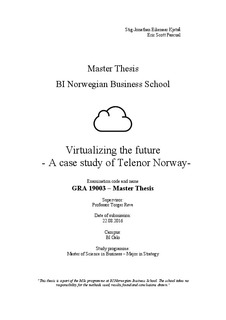| dc.description.abstract | The telecom industry is undergoing fundamental changes. Declining revenues in
traditional services, increased competition and increasingly digitized customers is
putting pressure on the very existence of the industry. At the core of telco is its
immense infrastructure, previously considered the true source of competitive
advantage. But as market dynamics changes, the cost of running the infrastructure
is becoming un-aligned with the revenues generated. Moreover, questions of
whether the current infrastructure is suitable in the transition from a traditional
communication services provider to the digital service provider, surfaces. From
the IT industry comes the concept of virtualization, which promises not only
regained flexibility and agility in the infrastructure, but also enhanced capabilities in addressing the future needs of highly digital consumers.
This thesis sets out to understand the potential of virtualization on a mobile
operator’s transition towards becoming a digital service provider. In an effort to
provide insight on this topic, we perform a case study on Telenor Norway, a
business unit of the large Norwegian telecommunications corporation Telenor
Group. Built on in-depth interviews with key personnel in Telenor and academic
scholars, in addition to an extensive amount of industry reports, this thesis developed and found support for three propositions relating to virtualization.
We performed three analyses to gain an understanding of the thesis topic. First,
we analysed the degree of disruptive potential of virtualization to gain insight in
its potential impact on mobile operators. Second, we performed a value network
analysis to show the cost effects of virtualization. Third and final, we analysed
how virtualization can aid the mobile operator in the transition from communication service provider towards becoming a digital service provider.
Our research found partial support for our propositions. First, we found partial
support for concluding that virtualization has a high degree of disruptive potential.
Virtualization had initial inferior performance, is simpler, cheaper and preferred
by niche- and low-end segments, but the overall maturity of the technology at this
stage of development is still of great concern for the mainstream customer. Second, we found that virtualizing the infrastructure can lead to great cost savings
in value-creating activities for the mobile operator. In particular, in terms of
investments and maintenance costs which can be reduced by nearly 40 % in a
five-year scenario. We did, however, find that more research needs to be provided
into developing comprehensive use-cases involving hidden implementation costs
such as investments in data centres and organizational change. Third and final, we
found that the business model of a digital service provider is greatly aided by the
presence of virtualized technology. However, we found that the successful
transition is dependent on a series of other factors such as investments in data
centres, organizational change and timing and hence that virtualization alone
cannot ensure the success. Overall, we found that virtualization has a strong potential of aiding the transition towards becoming a digital service provider. | nb_NO |
